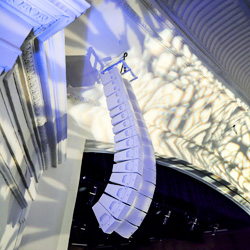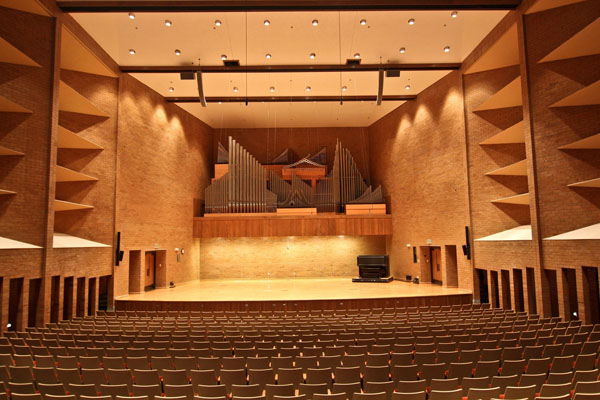
Brigham Young University, Idaho
A new sound reinforcement system for the Barrus Auditorium Concert Hall at BYU’s Idaho campus in Rexburg needed to provide higher quality audio without being visually intrusive.
Jon Perdue, A/V Production & Broadcast manager for the university, notes, “Barrus Auditorium also functioned as a chapel and the original sound system lacked clarity and wasn’t up to today’s standards in terms of quality for vocals and instrument reproduction.
“The university had authorized us to upgrade but the music department was very concerned about hanging a conventional system in the room or having groundstacked speakers alongside the stage for fear it would look intrusive,” Perdue adds.
A demo of the compact OmniLine array from Martin Audio, arranged with RMB Audio (Selma, NC), led to it being chosen for the 682-seat venue that hosts more than 110 events a year.
Specifically, Perdue and his crew hung 16 OmniLine modules per side, each with an AQ210 sub flown alongside to support the low frequency requirements for the program material without losing any clarity.

“Because it’s such an acoustically ‘live’ apace, they wanted a natural-sounding system. It had to be accurate and lend itself architecturally to the room’s design. That was a huge challenge, but the fact that the OmniLine boxes sound so musically and acoustically transparent was a major plus,” Perdue states.
Hawthorn Town Hall, Australia
Opening way back in 1890, Hawthorn Town Hall, located in a suburb of Melbourne, Australia, has taken on new life as a venue deemed integral to the artistic and cultural life of the community. The venue’s main hall presents very high ornate ceilings and long reverberation times (RT60 times greater than 2 seconds.
Hanson and Associates, the consultant on the project, set a very stringent set of criteria for the new system, including a minimum STI (Speech Transfer Index) of 0.6 coupled with a +/-3 dB variance between 80 Hz and 15 kHz across the entire listening area. Installation of delay zones was not feasible for aesthetic reasons, therefore the entire throw in the room (approximately 100 feet) had to be accomplished using only the front arrays.

It was determined that Adamson Metrix line arrays would meet these challenges, with main arrays (installed by Rutledge AV) each comprised of eight Metix-i modules flown left and right, with Metrix-Sub subwoofers also provided for applications requiring enhanced low end. The only additional loudspeakers in the system are attached to the face of the stage to bolster coverage to the front seating rows. The final array design created and optimized by Simon Tait of CMI, who also commissioned and tuned the system.
“The system delivers excellent speech intelligibility, consistency of coverage and tons of headroom,” says Tait. “Subjectively, it sounds superb at every seat and is eminently suited for applications as diverse as spoken word, musical theatre and full-blown rock.”
The Challenge Remains
The importance of acoustic modeling, coverage prediction, and system measurement and tuning for projects of this scope can’t be understated, but it’s such an involved topic that we’ll be focusing on it in-depth in the near future. Suffice to say that tools such as AFMG EASE predictive modeling is vital in helping to guide the design to an optimum result.
Also helpful are software programs provided by numerous loudspeaker manufacturers that enable the modeling of specific loudspeakers within a venue, so that coverage, overlaps between enclosures, expected SPL, and other aspects of system performance can be approximated before installation.
Finally, real-time audio measurement tools such as Rational Acoustics Smaart can provide a major assist in tuning systems and refining their coverage to achieve the best possible frequency response and coverage without unwanted attenuations and destructive overlaps between loudspeakers.
In the end, it all comes down to balancing audio fidelity and coverage with performance styles, architecture, aesthetics, and audience sight lines. A wide variety of loudspeaker designs are available to meet the challenge of sound reinforcement in performing arts centers, with even more in the works to further improve upon the flexibility, directivity control, output, and aesthetic factors that bring these performances to life.
Gary Parks is a pro audio writer and has worked in the industry for more than 25 years, including serving as marketing manager and wireless product manager for Clear-Com, handling RF planning software sales with EDX Wireless, and managing loudspeaker and wireless product management at Electro-Voice.
